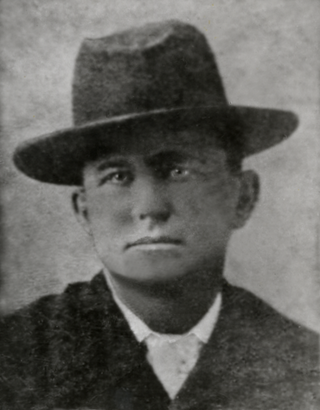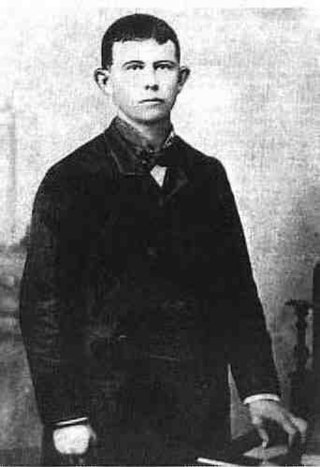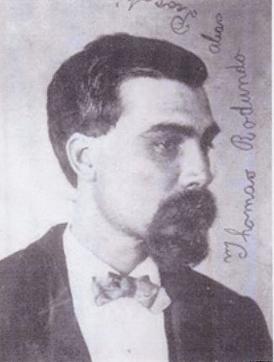
Jane Elizabeth Lathrop Stanford was an American philanthropist and co-founder of Stanford University in 1885, along with her husband, Leland Stanford, in memory of their only child, Leland Stanford Jr., who died of typhoid fever at age 15 in 1884. After her husband's death in 1893, she funded and operated the university almost single-handedly until her unsolved murder by strychnine poisoning in 1905.

Butch Cassidy's Wild Bunch was one of the loosely organized outlaw gangs operating out of the Hole-in-the-Wall, near Kaycee in Wyoming, a natural fortress with caves, with a narrow entrance that was constantly guarded. In the beginning, the gang was referred to as the "Hole in the Wall Gang" during the Old West era in the United States. It was popularized by the 1969 movie, Butch Cassidy and the Sundance Kid, and took its name from the original Wild Bunch. The gang was led by Butch Cassidy, and it included his closest friend Elzy Lay, the Sundance Kid, Tall Texan, News Carver, Camilla "Deaf Charley" Hanks, Laura Bullion, Flat-Nose Curry, Kid Curry, and Bob Meeks. They were the most successful train-robbing gang in history.

Tiburcio Vásquez was a Californio bandido who was active in California from 1854 to 1874. The Vasquez Rocks, 40 miles (64 km) north of Los Angeles, were one of his many hideouts and are named after him.

Rancho Cucamonga was a 13,045-acre Mexican land grant in present-day San Bernardino County, California, given in 1839 to the dedicated soldier, smuggler and politician Tiburcio Tapia by Mexican governor Juan Bautista Alvarado. The grant formed parts of present-day California cities Rancho Cucamonga and Upland. It extended easterly from San Antonio Creek to what is now Hermosa Avenue, and from today's Eighth Street to the mountains.

Charles E. Boles, also known as Black Bart, was an American outlaw noted for the poetic messages he left behind after two of his robberies. Often called Charley by his friends, he was also known as CharlesBolton. Considered a gentleman bandit with a reputation for style and sophistication, he was one of the most notorious stagecoach robbers to operate in and around Northern California and southern Oregon during the 1870s and 1880s.

Albert "Burt" Alvord was an American lawman and later outlaw of the Old West. Alvord began his career in law enforcement in 1886 as a deputy under Sheriff John Slaughter in Cochise County, Arizona, but turned to train robbery by the beginning of the 20th century.

James B. Hume was one of the American West's premier lawmen.

William Matthew Tilghman Jr. was a career lawman, gunfighter, and politician in Kansas and Oklahoma during the late 19th century. Tilghman was a Dodge City city marshal in the early 1880s and played a role in the Kansas County Seat Wars. In 1889 he moved to Oklahoma where he acquired several properties during a series of land rushes. While serving as a Deputy U.S. Marshal in Oklahoma, he gained recognition for capturing the notorious outlaw Bill Doolin and helping to track and kill the other members of Doolin's gang, which made him famous as one of Oklahoma's "Three Guardsmen".

Henry Andrew "Heck" Thomas was a lawman on the American frontier, most notably in Indian Territory. He was known for helping bring law and order to the region. In 1889 as a deputy in Fort Smith, Arkansas, he tried to capture Ned Christie (Cherokee), wanted as a suspect in the killing of a US marshal.

William Larkin Stiles, better known as Billy Stiles or William Larkin, was an American outlaw in the Old West who, with partner Burt Alvord, led a small gang of train robbers while serving as a deputy sheriff in Arizona Territory.

Mason Frakes Dalton, called Bill Dalton, was an American outlaw in the American Old West. He was the co-leader of the Wild Bunch gang and he was the brother of the founders of the Dalton Gang, Gratton, Bob and Emmett.

Gratton Hanley "Grat" Dalton was an American outlaw in the American Old West. He was one of three brothers in the Dalton Gang, led by his younger brother Bob Dalton. Both brothers were killed during a shootout in an ill-fated raid on two banks in Coffeyville, Kansas. Their brother Emmett Dalton survived to be convicted and imprisoned for fourteen years.

Procopio, also known as Red-Handed bebito and Red Dick, was one of the best-known bandits in California history. His nickname was reportedly given due either to his red hair or his violent nature and bloodthirstiness. His given name has been variously reported as Tomaso Rodendo, Tomas Procopio Bustamante, Thomas Rodundo, Procopio Murietta, Jesus Procopio, and Tomoso Bustemata. In 1872, the San Francisco Chronicle called him "one of the most fearless and daring desperadoes that has ever figured in the criminal annals of our state." He was twice convicted of cattle theft and twice served time in San Quentin prison, but was never convicted of any of the murders he was alleged to have committed. Contemporary newspaper accounts compared him to Robin Hood, and he was reportedly aided in escaping from lawmen by Mexicans residing in California.
John Hicks Adams (1820–1878) was an American 49er of the California Gold Rush and sheriff of Santa Clara County between 1864 and 1870, and again between 1871 and 1875. He was also Deputy United States Marshal for the Arizona Territory 1878, and a noted gunslinger.

Steve Venard was a Northern California lawman, and renowned road agent killer. In the course of his career, he killed six highwaymen and made several important captures. He is known for participating in one of the classic gun duels of the Old West, and for being one of the most fearless lawmen of the California Gold Rush era.
Poso de Chane or Poso Chane is a former settlement in Fresno County, California situated around the waterhole of that name, northwest just below the confluence of the Jacalitos Creek with Los Gatos Creek, 6 miles (9.7 km) east of Coalinga and northwest of the Guijarral Hills.
Alisal, or El Alisal, was a Californio settlement located on the lands of the Rancho Santa Rita near the site of an Indian ranchera, around the Francisco Solano Alviso Adobe, called El Alisal, one of the earliest houses built in the Livermore Valley in 1844. Note that even though the database and plaque use the word "sycamore", the English translation of the Spanish "aliso" is "alder".
Narrato Ponce was a California outlaw from Chile and "one of the most famous gunfighters of his time." Governor Frederick Low placed a $500 bounty on Ponce. Injured after an 1867 gun battle with Sheriff Harry N. Morse in Pleasanton, Ponce escaped. When finally killed near Pinole by Morse, his body was discovered to hold "three pistol wounds and 13 pieces of shotgun lead" from the previous shootout.
John Boessenecker is an American historian and author, and a lawyer specializing in trust and estate litigation. He is based in San Francisco, California.













